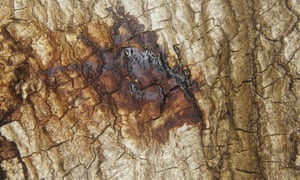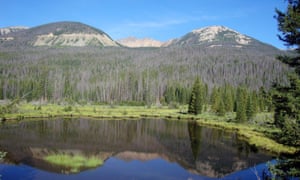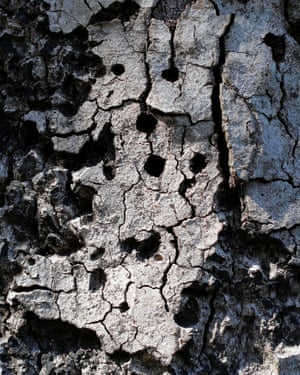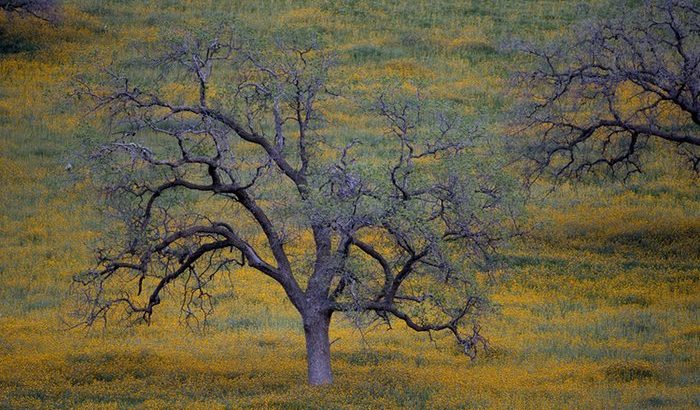A quiet crisis playing out in US forests as huge numbers of trees succumb to drought, disease, insects and wildfire – much of it driven by climate change
Resumen: Árboles han sido infectados conun virusque provoca en ellos una enfermedad misteriosa que ha asolado sólo los bosques tropicales del de Estados Unidos. La plaga que devastando los bosques estadounidenses en todo el oeste. Un ecólogo forestal de la Universidad de Hawai se encuentra realizando un estudio. Las hojas se vuelven amarillas, a continuación, marrón, más de unas pocas semanas – un cambio sorprendente para un árbol de hoja perenne. Esta hoy en día la mayor amenaza para nuestros bosques nativos que en años se ha visto. Si esto se extiende a través de toda la isla, que podría colapsar todo el ecosistema nativo «. Los científicos aún no están seguros de dónde vino o cómo tratarla. Lisa Keith, investigadora de la patología de las plantas en el Departamento de Agricultura de Estados Unidos, dijo que cuando se analizó la enfermedad «de inmediato la enfermedad del olmo holandés vino a la cabeza». Pero esto era diferente a todo lo que ella, o cualquier otra persona, nunca había tratado.
JB Friday hacked at a rain-sodden tree with a small axe, splitting open a part of the trunk. The wood was riven with dark stripes, signs of a mysterious disease that has ravaged the US’s only rainforests – and just one of the plagues that are devastating American forests across the west.
Friday, a forest ecologist at the University of Hawaii, started getting calls from concerned landowners in Puna, which is on the eastern tip of Hawaii’s big island, in 2010. Their seemingly ubiquitous ohi’a trees were dying at an astonishing rate. The leaves would turn yellow, then brown, over just a few weeks – a startling change for an evergreen tree.
“It was like popcorn – pop, pop, pop, pop, one tree after another,” Friday said. “At first people were shocked, now they are resigned.
“It’s heartbreaking. This is the biggest threat to our native forests that any of us have seen. If this spreads across the whole island, it could collapse the whole native ecosystem.”
Almost six years later and nearly 50,000 acres of native forest on the big island are infected with rapid ohi’a death disease. Rumors abound as to its origin: did it emerge from Hawaii’s steaming volcanoes? A strange new insect? Scientists still aren’t sure of where it came from or how to treat it.
Lisa Keith, researcher in plant pathology at the US Department of Agriculture, said that when she analyzed the disease “right away Dutch elm disease popped into my head”. But this was unlike anything she, or anyone else, had ever dealt with.
“I’m not sure if there’s been anything else like this in the world,” she said. “The potential is there for major devastation.” Keith said the disease hadn’t yet spread to crops, like coffee, but it threatens a whole family of metrosideros trees and shrubs found mainly in the Pacific.
But the plight of the ohi’a is not unique – it’s part of a quiet crisis playing out in forests across America. Drought, disease, insects and wildfire are chewing up tens of millions of trees at an incredible pace, much of it driven by climate change.
‘Mountainsides dying’
Forestry officials and scientists are increasingly alarmed, and say the essential role of trees – providing clean water, locking up carbon and sheltering whole ecosystems – is being undermined on a grand scale.
California and mountain states have suffered particularly big die-offs in recent years, with 66m trees killed in the Sierra Nevada alone since 2010, according to the Forestry Service.
In northern California, an invasive pathogen called Sudden Oak Death is infecting hundreds of different plants, from redwoods and ferns to backyard oaks and bay laurels. The disease is distantly related to the cause of the 19th-century Irish potato famine, and appears to have arrived with two “Typhoid Marys”, rhododendrons and bay laurels, said Dr David Rizzo, of the University of California, Davis.
“We’re talking millions of trees killed, whole mountain sides dying,” Rizzo said.

Despite its name, the pathogen slowly saps the life from oaks over the course of two to five years, turning them sickly brown. The disease spreads mostly through water, like rain splashing off an infected leaf on to a healthy neighbor. Rizzo said wind-driven rain could carry it miles at a time, and that it already ranged from the Oregon border down through the forests of Big Sur.
The pestilence appears to have arrived in the US through nursery plants in the 1980s, said Matteo Garbelotto, a professor at the University of California, Berkeley, who researches the genetics of the disease and trees that resist it. Garbelotto said researchers have found three distinct “subspecies” of the pathogen in the US – only one of which has escaped into the wild.
“There’s a bit of concern here that maybe we’re not doing enough to prevent introduction of other two lineages,” he said. Authorities have quarantined 15 counties to keep infected plants from leaving, but Garbelotto fears that authorities lack the resources to do more.
Native American tribes are helping Rizzo’s research near Oregon, and Garbelotto’s team developed a mobile app that users can direct at a given tree to determine its risk for disease, and what they can do to protect it.
“It’s a little bit like talking about mosquito abatement and malaria,” Garbelotto said of efforts to protect some trees by isolating them. “You try to reduce the number of vectors, eliminate immediate neighbors, a bit like putting a mosquito net around the tree.”
‘Insect eruptions’
Five years of drought in the west have not only starved trees of water but weakened their defenses and created conditions for “insect eruptions” across the US, said Diana Six, an entomologist at the University of Montana. Bark beetles and mountain pine beetles, usually held in check by wet winters, now have more time to breed and roam. The latter have already expanded their range from British Columbia across the Rockies, to the Yukon border and eastward, into jack pine forests that have never seen the bug.
The outbreak is “something like 10 times bigger than normal, I would argue a lot more than that,” Six said. “Basically a native insect is acting outside of the norm, because of climate change, and become an exotic in forests it’s never been before. We haven’t seen very good outcomes of exotics moving into native forests.”

Boosted by climate change, various beetles and the fungi they carry have already wiped out millions of acres of trees, and Six and Rizzo both warned of cascading effects. In the redwoods, Rizzo said, the loss of tanoaks and their relatives would strip away nut-producing species, leaving birds and mammals that rely on them without food. The loss of mountain pines, Six said, threatens grizzly bears and the critical snowpack that supplies water to life below.
“There’s virtually nothing you can do to stop the beetles, either, unless they’ve killed everything and run out of food,” Six said. “Or unless the climate cools, and I don’t think anyones expecting that anytime soon.”
In Hawaii, warming temperatures have helped spread four types of beetles that bore into ohi’a bark to feed. The beetles carry disease spore on their wings, in their guts and in the sawdust of burrows, spreading it from tree to tree.
The beetles are part of scolylinae, a “very destructive family” that is also decimating trees in California, according to Curtis Ewing, an entomologist at the University of Hawaii.
“They are exploding around the world due to global warming,” he said. They appear unstoppable: spraying each tree with insecticide would be time-consuming and made futile by rain, and pheromone-laced traps also appear ineffective. The university’s arboretum has started collecting ohi’a seeds in the face of a doomsday scenario that was recently unimaginable for such a common tree.
‘An ecological emergency’
Scientists in Keith’s lab have made some progress, finding that the fungal disease was part of the common ceratocystis family. It was probably imported to Hawaii by an ornamental plant, but a global DNA database drew a blank; this was an entirely new strain.

“I would’ve thought that with the extensive information there, there would’ve been a match,” Keith said. “It’s a worry.”
The spores look golden under the microscope and give off a fruity smell. Once they grip a tree the fungus clogs up the vascular system that trees use to draw water upwards. Leaves die, then the tree itself.
While research continues for a treatment, scientists’ current priority is containment. Movement of ohi’a between islands is prohibited, but with an uncertain source, there’s little else to do other than cut down infected trees and burn them.
“This is an ecological emergency,” said Hawaii senator Brian Schatz. “It requires everyone working together to save Hawaii island’s native forests.”
In western valleys of dead trees, a few still stand unharmed. Six said genetic research has begun to try to understand why some survive the swarms of millions of insects. “The only thing that’s really going to help our forests move into the future with climate change is adaptation,” she said. “Forests need to actually adapt with genetic change.”
In a few decades, Americans might not even recognize forests they see, Rizzo said. When his grandfather grew up near Philadelphia, he said, gigantic chestnut trees towered over eastern forests.
“When I show people photos they think they’re redwoods,” Rizzo said. When he hiked the Appalachian trial in the 1980s he found tiny sprouts of chestnuts, three-inches wide, stunted by an invasive blight that had wiped out the old giants.
“It changed chestnut forests to oak and hickory forests,” he said. “We know we can’t get rid of some of these blights. We may have to learn to live with them.”
Tomado de: https://www.theguardian.com/environment/2016/sep/19/tree-death-california-hawaii-sudden-oak






 Users Today : 182
Users Today : 182 Total Users : 35459777
Total Users : 35459777 Views Today : 341
Views Today : 341 Total views : 3418313
Total views : 3418313